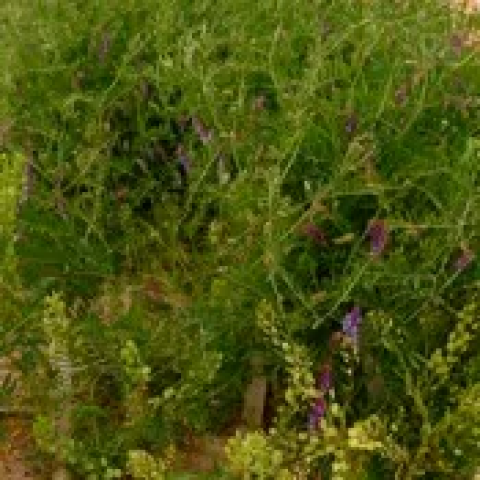Hairy Vetch

Hairy vetch is a winter hardy, annual legume. It is one of the best nitrogen-fixers and is reported to be more efficient at nitrogen fixation than peas. This makes it useful in vegetable crop rotations. Since it is slow to establish, it is usually sown with a nurse crop. Once established, it is good at weed suppression and soil conditioning.
Land Preparation
Prepare a well-drained seedbed free of weeds and clumps of soil. Hairy vetch performs poorly on compacted soils. It has high phosphorus and potassium requirements. Test soil for available phosphorus 40 lb/ac and potassium 120 lb/ac. Hairy vetch will tolerate a wide range of pH.
Seeding Rate
Drill 15-20 lb/ac. Drilling is preferred for uniformity. Broadcast 25-40 lb/ac. When seeding with a winter rye nurse crop, sow 20-30 lb/ac hairy vetch and 70 lb/ac winter rye. When seeding with an oats nurse crop in late summer, sow 40 lb/ac vetch and 80 lb/ac oats.
Seed Cost
2024 price $2.50/lb plus ~$10/ac for nurse crop plus inoculant
Seeding Dates
Late August-September.
Time Until Control
At flowering in early June.
Seed Suppliers
Local farm seed dealers, Ernst Conservation Seeds. Purple Bounty flowers earlier than VNS, allowing earlier termination in spring and potentially better synchronization with rye.
Management Tricks
- Use nurse crop.
- Mow or crimp at pod emergence (early June) to kill without herbicide.
Unavoidable Problems
Hard seed. Do not use in rotations with small grain because the grain will be contaminated with vetch seed.
Avoidable Problems
Hairy Vetch performs poorly on compacted soils. Root rot in rotations with other legumes. Slow to establish, use nurse crop (e.g. oats).
Classic Uses
Fall sown with rye for high-biomass overwintering crop
Maintenance
None.
Control
Mow or crimp at flowering in late May to kill without herbicide. Since most nitrogen fixation occurs in May, earlier control is not usually desirable. Incorporation will also control hairy vetch. Hairy vetch can become a weed problem if allowed to go to seed. Do not use in rotation with small grain because the hard seed of vetch will germinate in later years and contaminate the grain.
Tips
Hairy vetch is slow to establish and often needs a nurse crop. Wait a minimum of three years before another legume crop is planted because hairy vetch supports root rot and lesion nematodes. Root rot is not aggravated, however, when hairy vetch is planted in combination with small grains. Hairy vetch can serve as an alternate host for white mold. More information on hairy vetch is in the article on late summer legumes.
| Management Goal | Planting Time |
|---|---|
| Nitrogen Fixation | Late Summer |
| Reduce Surface Hardness | Late Summer |
| Reduce Weeds | Late Summer |
| Stabilize Soil Aggregates | Late Summer |
| Winter Erosion Protection | Late Summer |
